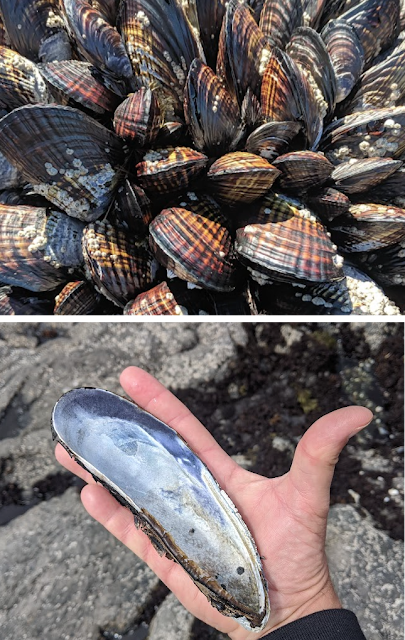Mussels are more than you might think...
1. Given that mussels are fairly quiet and sessile creatures, do they ever try to do some kind of fakery in their appearance? If so, why?
When you think about animals doing fakery, the word that should spring to mind is (as SRS Regular Reader Krossbow pointed out) is mimicry.
It's true that mussels are stationary for most of their lives, but they're not static. They can open their shells and do stuff. Plus, they've been evolving for around 500 megayears and are capable of quite rapid evolutions!
My first query was:
[ mussels mimicry ]
which quickly led me to find this result from PBS (the Nature series):
For example, females in the mussel genus Lampsilis have an extension of the mantle tissue that strikingly resembles a small fish. The mussel displays this tissue outside its shell between the valves and twitches it repetitively to attract its predaceous fish host – like a fishing lure.
Be sure to check out their video (especially at :52)
That's a wonderful example of mimicry which you can also see in
this video with a slightly different camera angle:
This is one of those cases when knowing just the right word works really well. In this case, knowing the vocabulary word mimicry makes a huge difference. This particular freshwater mussel, Lampsilis reeveiana, releases a huge cloud of mussel larvae (video), known as glochidia, some of which then attach themselves to the gills of fish that dares to try and eat the fake fish lure. (See the glochidia attach themselves to fish gills in this video.)
But that's not all... There's much more to discover, and that's the second part of this 3-part Challenge....
2. In addition to a fake fish lure, there are OTHER mimic devices that freshwater mussels use. Can you find them as well? (Think beyond a minnow sitting on top of the mussel shell.)
As always, let us know what you find and what you did to find it!
(Warning: These next couple of mimicry mechanisms are wild!)
Keep searching.

they mimic buttons?…
ReplyDeletehttps://www.indystar.com/picture-gallery/news/history/2023/09/05/freshwater-mussel-shells-were-made-into-buttons-in-the-early-1900s/70737126007/
https://www.emsl.pnnl.gov/news/drawing-inspiration-muscle-mussel-foot
just liked the project titles -
https://www.emsl.pnnl.gov/news/ten-months-twenty-projects-and-countless-scientific-advancements
https://www.researchgate.net/profile/Bernard-Sietman/publication/322320240_Host_attraction_brooding_phenology_and_host_specialization_on_freshwater_drum_by_4_freshwater_mussel_species/links/5c6dc0024585156b570d3965/Host-attraction-brooding-phenology-and-host-specialization-on-freshwater-drum-by-4-freshwater-mussel-species.pdf
https://scholar.google.com/scholar?q=mimicry+mechanisms+of+freshwater+mussels&hl=en&as_sdt=0&as_vis=1&oi=scholart
if Mussels had their own island/rock… (what is the silvery tube?)
ReplyDeletehttps://upload.wikimedia.org/wikipedia/commons/f/f1/Mussel_Rock_%2849811284671%29.jpg
https://en.wikipedia.org/wiki/Mussel_Rock#CITEREFSLSA1903
https://en.wikipedia.org/wiki/List_of_islands_of_California
bing, not goo
https://www.bing.com/search?q=mussel+mimicry+examples&qs=n&form=QBRE&sp=-1&lq=0&pq=mussel+mimicry+examples&sc=6-23&sk=&cvid=3CA7D209534A4F07AC75D00CCDDA0101&ghsh=0&ghacc=0&ghpl=
slight alteration:
https://www.bing.com/search?q=crafty+mussels+function&FORM=R5FD4
disguised as jewels - freshwater pearls
https://polarpedia.eu/en/pearls-from-freshwater-mussels/
"The freshwater pearl mussel is one of the longest-living invertebrates in existence. The oldest known specimen in Europe was caught in 1993 in Estonia when it was 134 years old."
https://en.wikipedia.org/wiki/Freshwater_pearl_mussel
Methuselah mussel -
"…he determined that it had a maximum lifespan of 210–250 years."
https://bioone.org/journals/ambio-a-journal-of-the-human-environment/volume-29/issue-2/0044-7447-29.2.102/Life-Span-Variation-of-the-Freshwater-Pearl-Shell--A/10.1579/0044-7447-29.2.102.short
in the Ukraine:
https://www.foliamalacologica.com/pdf-119762-53426?filename=A%20massive%20freshwater.pdf
https://www.semanticscholar.org/paper/Distribution%2C-abundance%2C-and-roles-of-freshwater-in-Strayer-Hunter/14c11d72650139a122b90a497d18c83d96b00d5e
I'll look for them. I wonder how you, Dr. Russell, find such great stuff. I know you observe and always reading, wanting to know and discovering. However, I'm sure there is something extra. A kind of gift you have. Thanks for sharing.
ReplyDeleteOn other topics. I was watching some birds this afternoon. And made think: How birds or other animals know where the water is? I mean the cup of water was in a new place and birds found it. How that works?
I'll try to find that too
Out of topic and related to Search, Research and Dr. Russell.
DeleteToday I read many people commenting about how Google Search results aren't what they were. And they shared this
I thought verbatim function was out of service.
How to Make Google Show You the Good Search Results Again
https://lifehacker.com/tech/how-to-get-more-accurate-google-search-results
I'm sure Google is working hard to have better results and more helpful ones.
They , I'm sure, are missing Dr. Russell and others like him that made a fantastic job and are not anymore there.